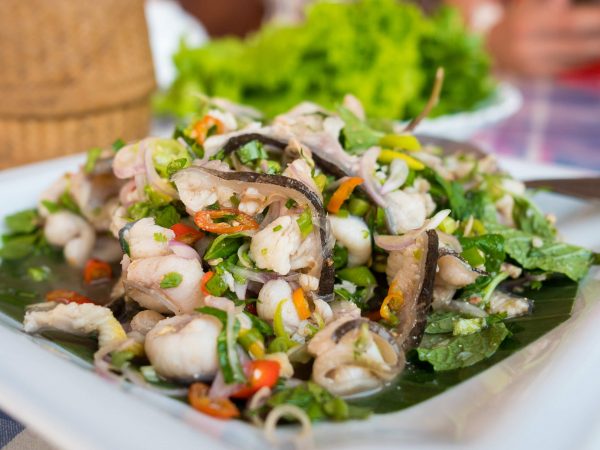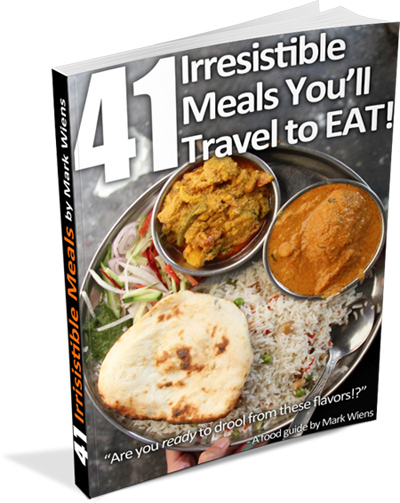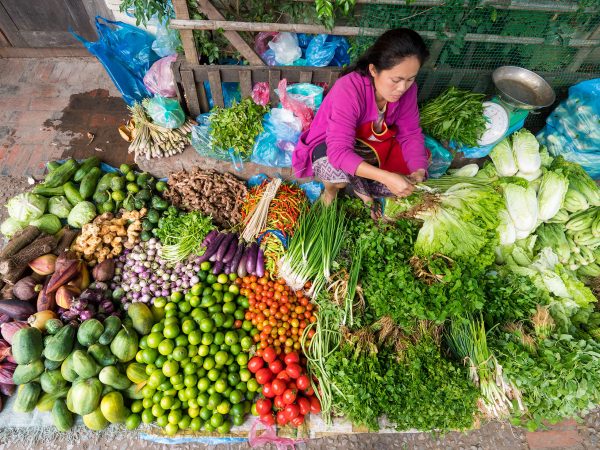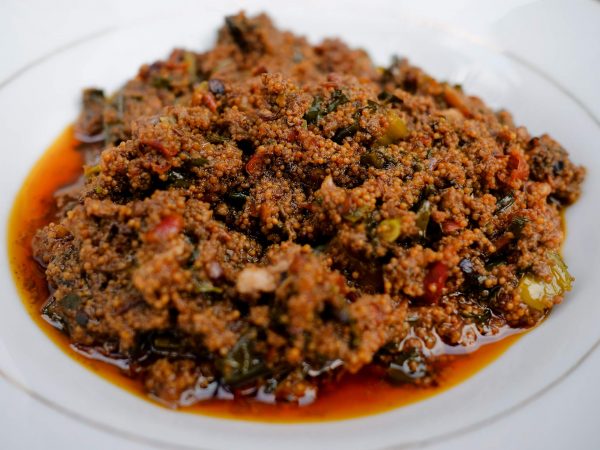
If you are going to travel so far from home, then why not do it for a mind-blowing new experience?
The next time life gives you a chance to explore, I encourage you to spend some time pushing personal boundaries.
I spent a few rewarding days experiencing life with a community of Khmu people, a tribe in Northern Laos, and I would love to share the details with you in this article.

Laos is the number one most diverse country in the entire world.
A total population of less than seven million people, Laos is made up of no less than 86 different groups.
For a country just slightly larger than the US State of Idaho (same size as the country of Romania), the variety and diversity here is quite simply mind-boggling.
The center of Northern Laos’ culture is likely Luang Prabang town, but in search of a specific and authentic cultural experience, one would definitely need to leave the perimeter of this wonderful town.
Don’t get me wrong, the town of Luang Prabang is a truly wonderful place, easily luring a traveler into enjoying a few days of hard-earned relaxation. It is not a joke to mention here how a highlight could be practicing how to relax the jaw after smiling for 48 hours straight.
The breeze that flows through Luang Prabang is almost medicinal its so peaceful, but there is really so much more to see when you travel here on your own.
Of course I got out each day to hunt for some authentic street food, but when I am in a new part of the world, there is always an underlying drive to explore. I was curious, and I just had to know more about that which lay beyond the small paradise around me.

I was hopeful to find an experience totally unique from those I had seen from life in the city. I wanted to do my best though to find it among people for whom it is ordinary – simply their daily life.
After doing a bit of research, I found the website of White Elephant Adventures.
Their mission involves respectfully highlighting and educating about relationships between the local peoples and their land, while also preserving those people’s ancient cultural identities.
As a bonus, we would not only visit the forests and farms at a walking pace, but also have the chance to take part in food preparation with the people who make recipes using that food daily.
After a few emails with the manager, I asked if we could set up a private tour. We wanted to keep our time open, and mainly focus on just people and food. We would be free of any plans in order to allow things to develop naturally from when we arrived.
These two days were wonderful, eye-opening, and honestly just fun – it couldn’t have gone any better.
I encourage you to watch the video of our first day here.

Heading out at 8AM
We all met up in the morning, shared some great bowls of Khao Piak Kao at a local street-side eatery, and then drove together for about 90 minutes to the first village. Along the way we stopped at a market to buy a few supplies, some gifts to bring to the families that would host us.
The road is mostly pavement but for a few bits of bumpy dirt. We knew that we were out of the city and approaching the real countryside of Laos.
We stopped a couple of times for quick engine tune-ups, giving us a chance to photograph the ridiculously steep hills surrounding the winding road.
A final half-hour of cruising and our rugged 8-person van pulled to stop beside a couple dozen large bamboo and thatch homes. Less than 60 seconds after we arrived there were already children venturing up to shake hands.

There may have been three dozen kids looking us all over, all still smiling. Any movement on our part instantly had most of them outright laughing. The situation was so laid back though, so comfortable in a way that made us all feel welcome – very much a feeling of being at home in this gentle mountain town.
Peace in a land so rich in diversity
The Khmu are experts at taking life at a relaxing pace. I can confirm that the feeling of peacefulness here was just about as complete as anywhere I can ever remember.
Get exclusive updates
Enter your email and I’ll send you the best travel food content.
Seeing though as how another town just a half-hour before was so noticeably different, I couldn’t help but ask about some basic facts of life.
I will try to give you just a brief overview – trust me when I say that it is hard to hold back.
Some Incredible History of the Khmu People
This area has had some very rough times in its history (the first number one statistic, Laos contains the most heavily bombed area of land on our entire earth), but knowing just makes an experience like this all the more incredible.
You will surely notice how in the present, daily life here is so full of calmness, so much beauty in coexistence of people from so very different histories.
For its quite modest size, Laos has a giant amount of people diversity. Again, on a per-capita basis, it is the number one most diverse country in the entire world.
All of these groups have their own totally distinct languages (over a hundred named languages in Northern Laos alone) and huge differences among their small but distinct identities!
I hope this can give you an idea of just how much there is to find here, literally hidden away in these appealingly sleepy jungle hills. If you want to learn even more about them, I have given a bit more detail at the bottom of this article.**
All that to say, and much, much more – and I haven’t even gotten to the food.

Watching them cook, You learn about more than just food
Now, getting back to the food experience, an opening with a picture like this is sure to provoke more than a few initial thoughts.
Honestly, witnessing it first-hand I felt very appreciative, simply grateful for the whole experience, and funny enough, I found myself thinking of my mother.
I may have grown up in a slightly larger town than these people here, but I am sure our mothers’ teachings were the same.
My mother would always teach me that I needed to use graciously everything I had been given. That is exactly what I was seeing in action – one life at an end, yet one received graciously and given on to strengthen the lives of others.
When food is being made entirely from scratch, all the steps are obvious and open. Seeing the steps allows you to more clearly understand the relationship we humans have with the food that sustains us.
Being thankful for the food that surrounds us of course includes what we take to our plate. I am always glad for an experience to learn from those who know. These people living here are just masters at making every little part count, it was so cool seeing them leaving nothing to waste.
Ultimate Respect for Life
The guys in the photo could give survival lessons to Bear Grylls. They use every single part of the pig from nose to tail, and head to toe. The speed at which they do it too makes it quite obvious that this is the traditional method.
This is the way they learn, it is how things have always been done here.
Immediately after the knife work finishes, they collect the still-running blood into a pan. This blood needs to stir constantly to stop coagulation. I was having fun imagining how many different kinds of things the chefs here do with such an ingredient.

Intestines and stomach go into a huge container, and straight down to the river for washing and cleaning.
Back to the outdoor kitchen area, they go into ready boiling water (just to blanch them, and not cook entirely). From there, finally to a wooden block while another part of the cooking team is dicing fresh herbs onto a plate.
When the butchering was over, there was time for a quick break. The first way to give thanks here is by enjoying fresh bites of meat – straight from the chopping block.
Looking back, this part is one of my favorite mental snapshots of the trip. The men cooking take turns inviting everyone within sight to come and enjoy a bite or two of fresh meat.
A small wai (bow/greeting) of respect precedes a careful arrangement of a single spoon bite. If you’re lucky, when its your turn to taste, the chef might even feed the bite right to you!

Everyone took a turn in some part of the food preparation, and it was probably only natural that those working inside the kitchen room were mostly female, while males tend to be the ones dealing with meat-matters outside.
It is a great experience to have a welcoming chef waiting to spoon ingredients directly to one’s mouth.
From a green-plastic drinking cup come long strips of pig skin and belly fat, all swimming in a steaming oniony soup.
We finish sampling, enjoying ourselves to the fullest, but I can tell that this is just a warm up for the party to come.
Reception of Esteemed Guests
One by one they invite us into the large family room. Many of the family were all ready, sitting around a wicker raised pedestal. On which were resting obviously important and older-looking family belongings.
The Baci (bah-see) tradition of welcome about to take place is something very ancient. Common among local families preceding the arrival of Buddhism, Baci is not a religious ceremony.
I have taken part in a Baci previously during each year of student graduations in Thailand where I once taught (common in SouthEast Asia, which includes the Thai countryside). Here among the Khmu in Northern Laos though, it was clear that this Baci was held with a considerably higher level of importance than that which I thought I knew.
They truly were welcoming us into their home in a way that, to them, felt the most real and respectful. They remind us that it is important to keep the white-strand blessings on our wrists for exactly 3 full days before removing them.
Be sure to check out the video footage to get an idea of what went on.
I was trying to limit my use of the camera out of respect for this memorable and beautiful ceremony of welcome, but I was itching to record it just so I could remember this special and simply just cool day!

The ceremony included food of course, and as it went on, I couldn’t quite tell when dinner actually began. We were honored to taste test the dishes first, along with the village elder and father of our friend Song (member of this Khmu tribe).
We were first presented with a Chinese cochin, and individual side plates of rice. Cochin is a chicken that you recognize by the strong yellow color of its skin. These chickens are much more lean and very flavorful when compared to the more common white-feather chicken.
I was again impressed by how warm of a welcome this was, the feeling being totally that of just hanging out together in the large front room of a friend’s home.

Party of both Modern and Traditional Style
Gradually the dinner end of the party was kicking off. I am sure you are happy as I was, to see the beautiful presentation of the home-style dishes.
As the next plates come out, we see together the final result of the blood which comes so painstakingly from the pig’s neck.
From the photo it might seem to be an appetizing but ordinary pile of fresh meat drenched in blood. You will be surprised though, to see how much precision is necessary to create this dish.
The chef adds plain water into an entire pot of herbs and blood, dipping it in using only a spoon. You may see a cook test this a full 15 times before it reaches a perfect blood-water ratio.
Another dish that will blow you away is the Or Laam, with Mai Sakaan, the Laos Spicy Chili Wood. The meat element in this dish is usually buffalo, specifically the parts including the buffalo skin. The broth is oily and the bites are chewy, this comfort food is one most dear to the Khmu people.

Lao Toh – Homemade Rice Wine
After dinner comes another very special recipe. This one may start off as rice, sometime in the distant past, but the finished product comes in liquid form. Bamboo straws are the only needed utensil, but a strong set of cheek and throat muscles will definitely help.
The specialty alcoholic beverage traditional throughout SouthEast is not beer – it is Rice Wine. When I lived in the Western world myself (during university studies), I got the feeling that while homemade beer or wine might culturally deserve a high-five, homemade alcohol from any other source is not so cool.
I think there are few things more wonderfully SouthEast Asian than the situation we found ourselves in here – Drinking rice wine in the house of a welcoming family we had met just hours before, surrounded by three generations of their family.
Besides the fact that in most Western countries it is illegal, probably due to the danger, I had never even thought much about an experience with homemade alcohol before coming to Asia. The setting here though was so totally family-friendly, I can’t imagine anyone dreaming to regulate it.
I have had versions in Thailand before, but those were always pre-strained, the contents transferred to glass containers or at least handed to me as a shot in a small cup. The liquid was always recognizable, as was the smell. In this case though, you can see that the container was a full village-size vessel, and actually it is fermented using exactly the same equipment as that used to make Laos PaDaek, the fermented fish.
The rice wine was wonderfully sweet! I was surprised by how hard it was to pull a drink up through the straw, but it was fun in its own way. The taste was accompanied by a strong smell as well, but it was great! Not like alcohol, but more like day old rice (or the Thai version of fermented rice called Khao Mao). This was not 1 day-old rice, but probably more like 90 days!
The vessel was probably finished hours later, it really was massive, but we passed it on to another circle of family members after each of us had a few lovely mouthfuls. Next up was karaoke, and therefore ended the purely cultural side of the dinner, but it was still completely in keeping with the warm-hearted welcome with which we were being blessed.
Finally, after hours of eating, hours of celebrating, and even a final round of eating some time later (probably a bit after midnight), the sleepy feelings from all that food could be fought off no longer.
For being such a small village, actually the sleeping arrangements were very comfortable. Two people to a bed, covered by a blanket and mosquito nets, nice big rooms with high ceilings, I honestly slept great.
Waking up in the morning I even felt like wearing long sleeves, the weather up here in the low mountains was significantly cooler even than back in town. Simply a magnificent day just passed, I was so happy to be waking up feeling full of life, ready to continue the journey, expecting just as much joy out of the day that was to come.
And now for those interested in learning even more about Laos and its people, here is what I gathered from a few hours of research after the trip was done. I have also included some links to other videos made on other days during the trip.
To simplify in terms of classification, information databases like Wikipedia gather all of these people into 3 groups: river/lowland living peoples, mid-mountain dwellers, and high-mountain living peoples.
The Khmu we visited would be a mid-mountain people, higher up into the hills than the Lao Lhum we visited in Vientiane, but still not yet the high-mountain dwellers like the Hmong we would visit the following day.
Laos is landlocked, a geography which usually finds a country developing much more slowly than its neighbors. For better or for worse, when you travel to Laos you can immediately appreciate how Laos really is a land trapped in time.
Venturing just a few kilometers outside even the largest of cities, you will find quiet dirt roads, gently flowing waters, even plenty of virgin forest (Laos is also the #1 Most-Forested country on earth by percent of land area).
Usually following animist beliefs, more than 50% of the current population of Khmu people would pay daily tribute to some supernatural deity, usually speaking through a village elder, a wise man who would call himself a shaman.
The history of this land stretches back over a thousand years. The forest being as dense as it is, and also the people so relaxed (also the groups so small!), that it isn’t easy to find much information about them (in English that is). Before the year 2010, a neighboring group of peoples called the Hmong have their entire culture detailed due almost entirely to the research of just one man from France.
The Hmong are the third largest minority group in the country, hundreds of thousands of people (Lao of course being the largest, and Khmu the second), and if you look at their Wikipedia page, aside from a description of the location of where these people live, the article only goes into detail in how these people are not like the other small groups in the area.
The Khmu people, like nearly every ethnic group in SouthEast Asia, have a name which actually refers to a large group of people who share similar languages, location, and ways of life. There are specific groups which refer to each other by name, know each other by both location and habit, but to outsiders the name to refer to all of the diversity included is simply “Khmu.” This is also a very common situation in many, many of the world’s ‘developing’ nations.
In terms of cultural diversity, I am sure you would enjoy seeing just how different these people are from other groups around, living on the same mountainside or even sharing a river with people who speak a different language.
By population, you can find Laos on a world chart as similar in size to El Salvador or Denmark, and by size of land area you can see it is roughly the same size as Romania.
I hope you have enjoyed these facts and observations, I really just can’t get enough of Laos, and its safe to say that I am more than a bit excited for my next trip to Laos, whenever it may be.
Thank you to White Elephant Adventures for taking us on this culinary adventure and learning experience with a Khmu community in Laos.
Get exclusive updates
Enter your email and I'll send you the best travel food content.



